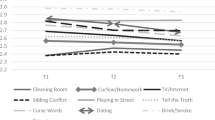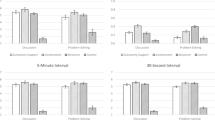Abstract
The current study focused on the childhood to adolescence transition and sought to determine why some children are more compliant than others as well as why children comply more often with some of their parents’ rules than with others. Indices of parents’ agency and children’s agency were tested as predictors of compliance. Parent-based decision-making and parents’ responses to expressed disagreement served as indices of parents’ agency while children’s beliefs regarding the legitimacy of parents’ rules and felt obligation to obey rules served as indices of children’s agency. Parent–child dyads (n = 218; 51 % female, 49 % European American, 47 % African American) were interviewed during the summers following the children’s 5th (M adolescent age = 11.9 years) and 6th grade school years. Children who felt that their parents’ rules were more legitimate were more compliant overall than were children who felt that the rules were less legitimate. Children compiled more with rules governing topics perceived to be legitimately regulated by parents, when parents made more decisions regarding the topic and when parents responded to disagreement by standing strong. Results were generally consistent across parents’ and children’s reports of compliance and across cross-sectional and longitudinal analyses. At the transition from childhood to adolescence, only children’s agency explained why some children are more compliant than others, but parents’ and children’s agency helped to explain why children complied with some rules more than others.
Similar content being viewed by others
References
Brooks-Gunn, J. (1991). How stressful is the transition toward adolescence for girls? In M. Colten & S. Gore (Eds.), Adolescent stress: Causes and consequences (pp. 131–149). Hawthorne, NY: Aldine de Gruyter.
Bryk, A. S., & Raudenbush, S. W. (1992). Hierarchical linear models in social and behavioral research: Applications and data analysis methods (1st ed.). Newbury Park, CA: Sage Publications.
Bylund, C. L., Baxter, L. A., Imes, R. S., & Wolf, B. (2010). Parental rule socialization for preventive health and adolescent rule compliance. Family Relations, 59, 1–13. doi:10.1111/j.1741-3729.2009.00583.x.
Crockenberg, S., & Litman, C. (1990). Autonomy as competence in 2-year-olds: Maternal correlates of child defiance, compliance and self-assertion. Developmental Psychology, 26, 961–971. doi:10.1037/0012-1649.26.6.961.
Darling, N., Cumsille, P., & Martínez, M. L. (2007). Adolescents as active agents in the socialization process: Legitimacy of parental authority and obligation to obey as predictors of obedience. Journal of Adolescence, 30, 297–311. doi:10.1016/j.adolescence.2006.03.003.
Darling, N., Cumsille, P., & Martínez, M. L. (2008). Individual differences in adolescents’ beliefs about the legitimacy of parental authority and their own obligation to obey: A longitudinal investigation. Child Development, 79, 1103–1118. doi:10.1111/j.1467-8624.2008.01178.x.
Darling, N., Cumsille, P., Peña-Alampay, L., & Coatsworth, D. (2009). Individual and issue-specific differences in parental knowledge and adolescent disclosure in Chile, the Philippines, and the United States. Journal of Research on Adolescence, 19, 715–740. doi:10.1111/j.1532-7795.2009.00608.x.
Dishion, T. J., Nelson, S. E., & Bullock, B. M. (2004). Premature adolescent autonomy: Parent disengagement and deviant peer process in the amplification of problem behaviour. Journal of Adolescence, 27, 515–530. doi:10.1016/j.adolescence.2004.06.005.
Dornbusch, S. M., Carlsmith, J. M., Bushwall, S. J., Ritter, P. L., Leiderman, H., Hastorf, H., et al. (1985). Single parents, extended households, and the control of adolescents. Child Development, 56, 326–341. doi:10.2307/1129723.
Entwistle, D. R., & Astone, N. M. (1994). Some practical guidelines for measuring youth’s race/ethnicity and socioeconomic status. Child Development, 65, 1521–1540. doi:10.1111/j.1467-8624.1994.tb00833.x.
Fan, X., & Sun, S. (2013). Generalizability theory as a unifying framework of measurement reliability in adolescent research. The Journal of Early Adolescence,. doi:10.1177/0272431613482044.
Fuligni, A. J. (1998). Authority, autonomy, and parent–adolescent conflict and cohesion: A study of adolescents from Mexican, Chinese, Filipino, and European backgrounds. Developmental Psychology, 34, 782–792. doi:10.1037/0012-1649.34.4.782.
Grusec, J. E., & Goodnow, J. J. (1994). Impact of parental discipline methods on the child’s internalization of values: A reconceptualization of current points of view. Developmental Psychology, 30, 4–19. doi:10.1037/0012-1649.30.1.4.
Holmbeck, G. N., Paikoff, R. L., & Brooks-Gunn, J. (1995). Parenting adolescents. In M. H. Bornstein (Ed.), Handbook of parenting (Vol. 1, pp. 91–118). Mahwah, NJ: Erlbaum.
Keijsers, L., Branje, S., Van der Valk, I., & Meeus, W. (2010). Reciprocal effects between parental solicitation, parental control, adolescent disclosure and adolescent delinquency. Journal of Research on Adolescence, 20, 88–113. doi:10.1111/j.1532-7795.2009.00631.x.
Kochanska, G., Coy, K. C., & Murray, K. T. (2001). The development of self-regulation in the first four years of life. Child Development, 72, 1091–1111. doi:10.1111/1467-8624.00336.
Kuczynski, L., & Hildebrandt, N. (1997). Models of conformity and resistance in socialization theory. In J. E. Grusec & L. Kuczynski (Eds.), Parenting and children’s internalization of values: A handbook of contemporary theory (pp. 227–256). New York: Wiley.
Kuhn, E. S., & Laird, R. D. (2011). Individual differences in early adolescents’ beliefs in the legitimacy of parental authority. Developmental Psychology, 47, 1353–1365. doi:10.1037/a0024050.
McNeil, C. B., & Hembree-Kigin, T. L. (2010). Parent–child interaction therapy (2nd ed.). New York: Springer.
National Center for Education Statistics. (2003). Common core of data: Public elementary/secondary school universe survey data for 2001–2002 (Version 1a) [Data file]. Available from http://www.nces.ed.gov.
Park, H.-S., & Bauer, S. (2002). Parenting practices, ethnicity, socioeconomic status and academic achievement in adolescents. School Psychology International, 23, 386–396. doi:10.1177/0143034302234002.
Pettit, G. S., Bates, J. E., Dodge, K. A., & Meece, D. W. (1999). The impact of after-school peer contact on early adolescent externalizing problems is moderated by parental monitoring, perceived neighborhood safety, and prior adjustment. Child Development, 70, 768–778. doi:10.1111/1467-8624.00055.
Phinney, J., Kim-Jo, T., Osorio, S., & Vilhjalmsdottir, P. (2005). Autonomy and relatedness in adolescent-parent disagreements: Ethnic and developmental factors. Journal of Adolescent Research, 20, 8–39. doi:10.1177/0743558404271237.
Piehler, T. F., & Dishion, T. J. (2007). Interpersonal dynamics within adolescent friendship: Dyadic mutuality, deviant talk, and patterns of antisocial behavior. Child Development, 78, 1611–1624. doi:10.1111/j.1467-8624.2007.01086.x.
Schafer, J. L., & Graham, J. W. (2002). Missing data: Our view of the state of the art. Psychological Methods, 7, 147–177. doi:10.1037/1082-989X.7.2.147.
Smetana, J. G. (1999). The role of parents in moral development: A social domain analysis. Journal of Moral Education, 28, 311–321. doi:10.1080/030572499103106.
Smetana, J. G. (2000). Middle-class African-American adolescents’ and parents’ conceptions of parental authority and parenting practices: A longitudinal investigation. Child Development, 71, 1672–1686. doi:10.1111/1467-8624.00257.
Smetana, J. G. (2011). Adolescents, families and social development: How teens construct their worlds. Malden, MA: Wiley-Blackwell.
Smetana, J. G., & Asquith, P. (1994). Adolescents’ and parents’ conceptions of parental authority and adolescent autonomy. Child Development, 65, 1147–1162. doi:10.2307/1131311.
Smetana, J. G., Campione-Barr, N., & Daddis, C. (2004). Longitudinal development of family decision making: Defining healthy behavioral autonomy for middle-class African American adolescents. Child Development, 75, 1418–1434. doi:10.1111/j.1467-8624.2004.00749.x.
Smetana, J. G., Metzger, A., Gettman, D. C., & Campione-Barr, N. (2006). Disclosure and secrecy in adolescent–parent relationships. Child Development, 77, 201–217. doi:10.1111/j.1467-8624.2006.00865.x.
Soenens, B., Vansteenkiste, M., Lens, W., Luyckx, K., Goossens, L., Beyers, W., et al. (2007). Conceptualizing parental autonomy support: Adolescent perceptions of promotion of independence versus promotion of volitional functioning. Developmental Psychology, 43, 633–646. doi:10.1037/0012-1649.43.3.633.
U. S. Census Bureau. (2000). Profile of selected social characteristics: Baton Rouge city, Louisiana. Retrieved from http://factfinder.census.gov/servlet/QTTable?_bm=y&-geo_id=16000US2205000&-qr_name=DEC_2000_SF1_U_DP1&-ds_name=DEC_2000_SF1_U&-_lang=en&-redoLog=false&-_sse=on.
Van Petegem, S., Beyers, W., Vansteenkiste, M., & Soenens, B. (2012). On the association between adolescent autonomy and psychosocial functioning: Examining decisional independence from a self-determination theory perspective. Developmental Psychology, 48, 76–88. doi:10.1037/a0025307.
Vansteenkiste, M., Soenens, B., Van Petegem, S., & Duriez, B. (2013). Longitudinal associations between adolescent perceived degree and style of parental prohibition and internalization and defiance. Developmental Psychology,. doi:10.1037/a0032972.
Wray-Lake, L., Crouter, A. C., & McHale, S. M. (2010). Developmental patterns in decision-making autonomy across middle childhood and adolescence: European American parents’ perspectives. Child Development, 81, 636–651. doi:10.1111/j.1467-8624.2009.01420.x.
Acknowledgments
This research was supported by grants from the National Science Foundation (BCS 0517980 and 0807650) to R. D. Laird and the Louisiana Board of Regents to R. D. Laird and Jenny M. Phan. We thank the teachers and principals from the East Baton Rouge Parish School System and the families who participated in this research.
Author Contributions
ESK conducted the literature review and drafted the manuscript; JMP conceived of the study, performed the statistical analyses and helped to draft the manuscript; RDL designed and coordinated the study, supervised the analyses, and helped to draft the manuscript. All authors read and approved the final manuscript.
Author information
Authors and Affiliations
Corresponding author
Rights and permissions
About this article
Cite this article
Kuhn, E.S., Phan, J.M. & Laird, R.D. Compliance with Parents’ Rules: Between-Person and Within-Person Predictions. J Youth Adolescence 43, 245–256 (2014). https://doi.org/10.1007/s10964-013-9965-x
Received:
Accepted:
Published:
Issue Date:
DOI: https://doi.org/10.1007/s10964-013-9965-x




